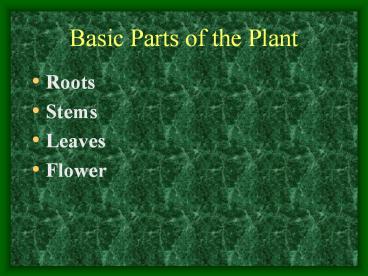Basic Parts of the Plant - PowerPoint PPT Presentation
Title:
Basic Parts of the Plant
Description:
Basic Parts of the Plant Roots Stems Leaves Flower Roots 1. Anchor Plant 2. Absorb water and minerals 3. Translocate water and minerals to stem 4. – PowerPoint PPT presentation
Number of Views:191
Avg rating:3.0/5.0
Title: Basic Parts of the Plant
1
Basic Parts of the Plant
- Roots
- Stems
- Leaves
- Flower
2
Roots
- 1. Anchor Plant
- 2. Absorb water and minerals
- 3. Translocate water and minerals to stem
- 4. Store Food
3
Stems
- 1. Translocate water, minerals and food to the
leaves - 2. Support the leaves and display them to light
- 3. Store Food
4
Leaves
- 1. Make food through photosynthesis
- 2. Provide site of gas exchange
- 3. Store food
5
Flowers
- 1. Contain organs for specialized sexual
production - 2. Produce seeds and fruit
6
Different type of Roots
- A. Tap Root
- Continuation of the primary root
- Ideal for anchorage
- Penetration is greater for water
- Storage area for food made by photosynthesis
7
ARE YOU PAYING ATTENTION?
- THERE JUST MAY BE A QUIZ!!!
8
Different type of Roots
- B. Fibrous Roots
- Many finely branched secondary roots
- Shallow roots cover a large area
- More effective absorption of water and minerals
- Roots hold the soil to prevent erosion
9
Different type of Roots
- C. Aerial roots
- Clinging air roots
- Short roots that grow horizontally from the stems
- Roots that fasten the plant to a support
- Absorptive air roots
10
Different type of Roots
- Adventitious Roots
- Develop in places other than nodes
- Can form on cuttings and rhizomes
11
Roots
- Root hairs
- Tiny one celled hair like extensions of the
epidermal cells located near the tips of the
roots where vascular tissues have formed. - Increase surface area
- Absorb water and minerals from soil
12
Specialized Stems
- A. Corm (gladiolus, crocus)
- underground
- Solid, fleshy, scale covered
13
WAKE UP!!!!!!!!!!!!
- DONT FALL ASLEEP
- PAY ATTENTION!
- THIS MEANS YOU!!!
14
Specialized Stems
- B. Bulb (tulips, lillies, onions)
- Layers of fleshy scales that overlap each other
- Underground stem
15
Specialized Stems
- C. Tuber (potato, caladium)
- Food storage area
- Short, thick underground stem
16
Specialized Stems
- D. Crown (African Violets, fern)
- Closely grouped stems or plantlets
- Just above ground or just below
17
Specialized Stems
- E. Spurs (pear and apple trees)
- Short sems found on woody plant limbs adapted for
increased production of fruits
18
Specialized Stems
- F. Rhizomes (iris, lily of the valley)
- Underground stems that produce roots on the lower
surface and extend leaves and flower shoots above
the ground
19
Specialized Stems
- G. Stolon (Strawberry, airplane plant)
- Stem that grows horizontally above the soil
surface
20
Principal Tissues of the Leaf
- Epidermis
- Cuticle
- Waxy substance covers the leaves and stems
- Waterproof layer that keeps water in plants
21
Principal Tissues of the Leaf
- Epidermis (cont)
- Stomata
- Openings in the epidermis mainly located on
underside of leaves - Exchange of gases
22
Principal Tissues of the Leaf
- Epidermis (cont)
- Guard Cells
- Two cells located on each side of stomata
- Open and closes stomata
23
Principal Tissues of the Leaf
- Mesophyll layer
- Palisade mesophyll
- Primary site of photosynthesis
- Spongy mesophyll
- Contains air and chloroplasts
- Site of photosynthesis and gas exchange
24
Principal Tissues of the Leaf
- Veins or vascular bundles
- In spongy mesophyll
- Phloem tissues conduct food from photosynthesis
to rest of plant - Xylem tissues conduct water and minerals up to
cells in leaves and stems
25
Parts of the Flower
- Sepals
- Outer covering of the flower bud
- Protects the stamens and pistills when flower is
in bud stage
26
Parts of the Flower
- Petals
- Brightly colored
- Protects stamen and pistills
- Attracts pollinating insects
27
Parts of the Flower
- Stamens
- Male Reproductive part
- Anther-produces pollen
- Filament-supports the anther
28
Parts of the Flower
- Pistil
- Female reproductive part
- Ovary
- Enlarged portion at base of pistill
- Produces ovules which develop into seeds
- Stigma
- Holds the pollen grains
29
Parts of the Flower
- Style
- Connects the stigma with ovary
- Supports the stigma so that it can be pollinated
30
Complete and Incomplete Flowers
- Complete have all four main parts
- Sepals
- Petals
- Stamens
- Pistils































